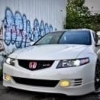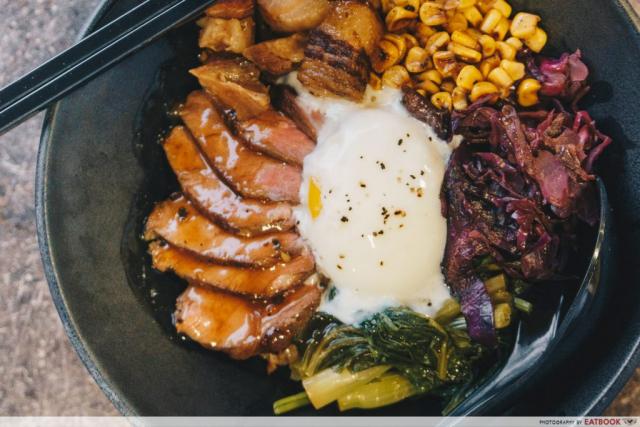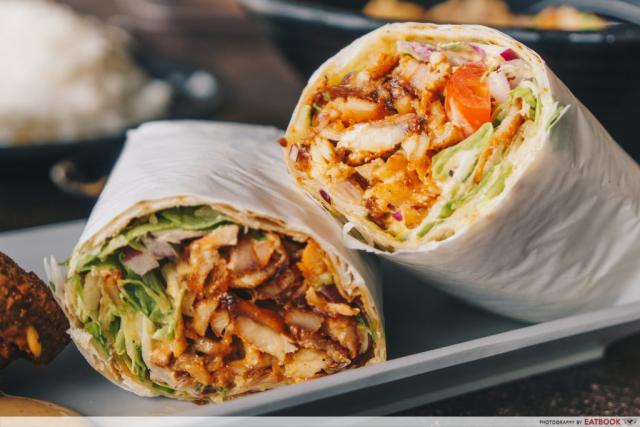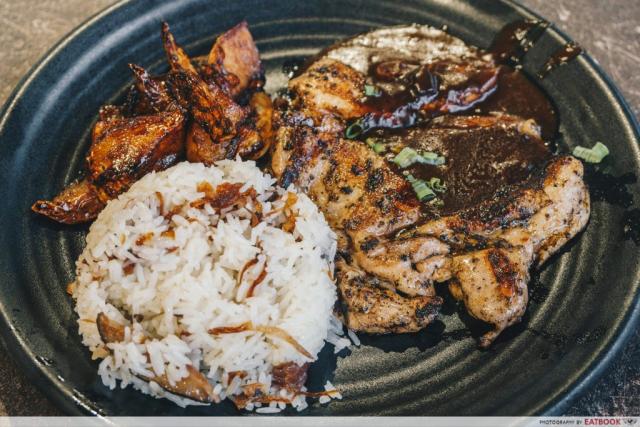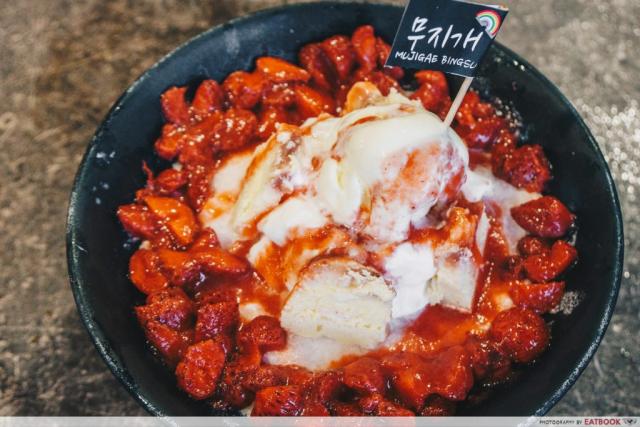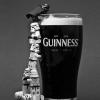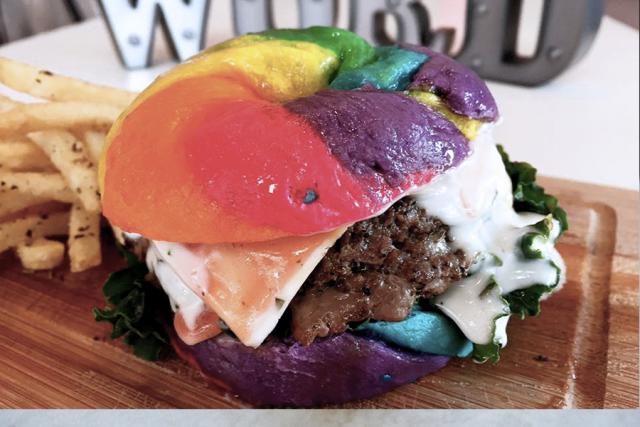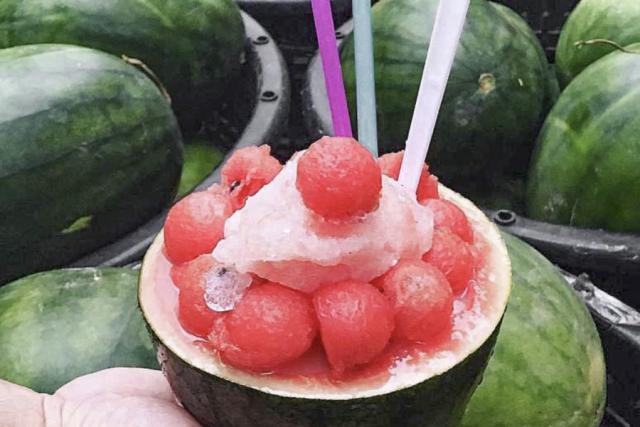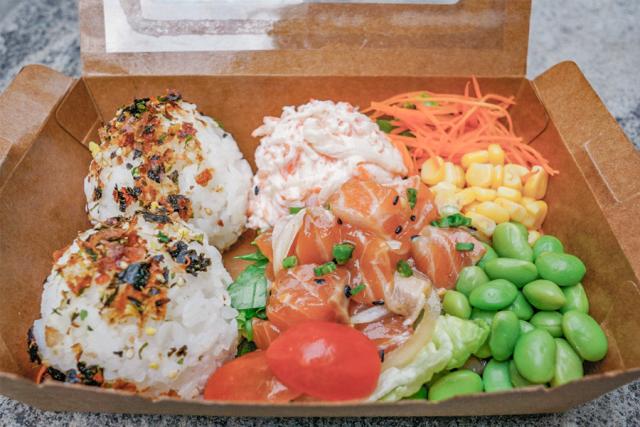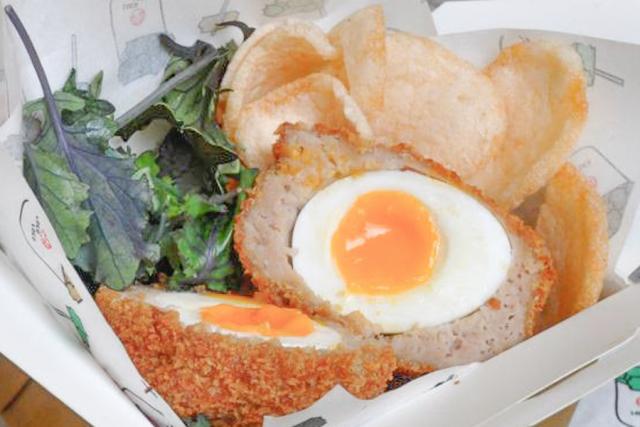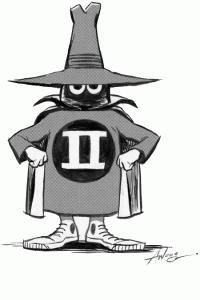Search the Community
Showing results for tags 'Food'.
-
Just venting cos I found the situation so frustrating. Currently in a crowded food court. Managed to get a seat for myself and my daughter after a long while looking for empty seats. I saw a family of 4 at a set of 3 small tables joined together. Each small table can seat 2. Went ahead and asked the father if tge space at the third table was taken....It was. ..by his son's bag. His reply. .."too cramped". I looked at hi and said "II am shifting the table." And proceeded to do so. How selfish people can be even when they don't need the space and don't care if people are looking or waiting for seats. : (
- 38 replies
-
- 7
-

-
- food court antics
- selfish
-
(and 4 more)
Tagged with:
-
Chinese New Year is coming. Yu Sheng, or Cantonese as lou hei, is one of the main dishes that most people will get to eat during Chinese New Year. Yusheng, yee sang or yuu sahng (Chinese: 魚生; pinyin: yúshēng), or Prosperity Toss, also known as lo hei (Cantonese for 撈起 or 捞起) is a Cantonese-style raw fish salad. It usually consists of strips of raw fish (sometimes salmon), mixed with shredded vegetables and a variety of sauces and condiments, among other ingredients. Yusheng literally means "raw fish" but since "fish (魚)" is commonly conflated with its homophone "abundance (余)", Yúshēng (魚生) is interpreted as a homophone for Yúshēng (余升) meaning an increase in abundance. Therefore, yusheng is considered a symbol of abundance, prosperity and vigor. While versions of it are thought to have existed in China, the contemporary version was created and popularised[citation needed] in the 1960s amongst the ethnic Chinese community and its consumption has been associated with Chinese New Year festivities in Malaysia, Indonesia and Singapore. Today, the common form of yusheng is the qicai yusheng (七彩鱼生; “seven-coloured raw fish salad”) served in local restaurants during the Chinese New Year period. Also referred to as facai yusheng (发财鱼生; “prosperity raw fish salad”) or xinnian yusheng (新年鱼生; “Chinese New Year raw fish salad”), this colourful take on yusheng was said to be created in the 1960s by chefs Lau Yoke Pui, Tham Yui Kai, Sin Leong and Hooi Kok Wai, together known as the “Four Heavenly Kings” in the Singapore restaurant scene. The recipe included ingredients such as shredded white and green radish and carrots, ginger slices, onion slices, crushed peanuts, pomelo, pepper, essence of chicken, oil, salt, vinegar, sugar and more. To enhance the taste, the chefs began the practice of pre-mixing the sauce in order to ensure a balanced taste for each dish as compared to the past when diners mixed the sauce themselves. This new way of eating yusheng was not readily accepted until the 1970s when younger diners embraced it. From then on, the popularity of this yusheng recipe soared and spread overseas. https://en.wikipedia.org/wiki/Yusheng So, any good recommendations for good yu sheng this year? And how often do you eat yu sheng during the 2 weeks of Chinese New Year celebrations?
- 46 replies
-
- 5
-

-
- chinese new year
- yu sheng
- (and 5 more)
-
During Chinese New Year, we will definitely buy some Chinese New Year goodies, aka snacks, junk food, etc, to serve our relatives and friends when they come to your house for visits during this period, or for won consumption. Some families will buy a lot of these goodies because of sales and some will buy very less, as to not to waste food and money. The common food that people will buy for Chinese New Year are snacks like pineapple tarts, kuek lapis, egg rolls/love letters, Bak kua, packet/canned drinks and other food like canned abalones, dried mushrooms and fish maws, sao la, etc. For those who buy a lot, they will take months to finish, even months after the 2 week Chinese New Year celebrations. For those who buy too little, the food is almost finished even before the first day of Chinese New Year celebration starts. How long do you take to finish your Chinese New Year goodies and food?
- 23 replies
-
- food
- cny goodies
-
(and 3 more)
Tagged with:
-
Fast food meals have fewer calories than restaurant dishes, BMJ finds Fast food meals are less calorific than many restaurant dishes, research published in the BMJ has found. The study found that meals served by popular high street eateries - including Harvester and Hungry Horse - contain more than twice the amount of recommended calories. Health officials say that a main meal should contain no more than 600 calories. But the study found that the average dish served in a chain restaurant contains 1033 calories. The figure far exceeds the average 751 calorie countent found in meals served by fast-food joints including MacDonalds, Wimpy and Burger King. The biggest offenders were the Hungry Horse and Stone House restaurant chains, which which clocked up 1,358 and 1,275calories in an average main meal respectively. Other well-known restaurant chains with high calorie content included Harvester, at 1,166 calories, JD Wetherspoon, with 1119 calories, and Nandos, on 1,019 calories. Advice issued by Public Health England in March said people should be aiming to consume 600 calories for lunch and dinner. Author Dr Eric Robinson, a behavioural psychologist at Liverpool University, said the findings were "shocking". But he warned that they under-estimate the true picture, since drinks, starters, desserts and side orders were excluded from the study. He said: "Only one-in-ten of the meals we surveyed could be considered a healthy number of calories. "Although some of the results are shocking our findings probably underestimate the number of calories consumed in restaurants because our analysis did not include drinks, starters, desserts or side orders." He said: "It's really clear what the food industry need to do - they need to act more responsibly and reduce the number of calories that they're serving." Britain’s restaurant habits are fuelling its obesity crisis he said, with four in ten adults eat out at least once a week. Dr Robinson said the poor nutritional content of 'fast food' is well known but full service restaurants where dining tables are provided have received less attention. The study analysed the calories in 13,500 main meals from 21 full-service and six fast-food chains. Among fast food chains, meals at Burger King had an average of 711 calories, followed by Wimpy, at 721 calories, and McDonald’s at 726 calories. The highest meal in a restaurant classed as “fast-food” was at KFC, with an average of 987 calories. Dr Robinson said: "On average, the energy content of main meals served by full service restaurants was 268 calories higher than that of main meals served by fast food restaurants.” Researchers said many public health experts had focussed concern on fast foods, but not paid enough attention to the stodgy and fatty fare sold in high street restaurants. The UK is the most overweight nation in Western Europe - with levels of obesity growing faster than in the US. Last year a study by the Organisation for Economic Cooperation and Development (OECD) said Britain was the sixth-worst country in its 35 member states - coming behind Mexico, the USA, New Zealand, Finland and Australia. Two in three adults are overweight or obese. The Government is consulting on introducing mandatory calorie labels on restaurant menus, while health officials are working on plans to cut the calorie content of meals. https://www.msn.com/en-sg/health/fitness/fast-food-meals-have-fewer-calories-than-restaurant-dishes-bmj-finds/ar-BBQYCUr?ocid=spartanntp
-
So, anyone going there to get free food? Mayb can consider a MU there, walk walk see see and eat a eat eat. http://singaporefoodshows.com.sg/world-food-fair/
-
http://v.youku.com/v_show/id_XMTU5ODM3MDUy.html The video is in mandarin but the graphical effect should be pretty entertaining for most. Enjoy your meal:)
- 5 replies
-
- 1
-

-
- Wild
- Collection
- (and 4 more)
-
http://eatbook.sg/pasir-ris-central-hawker/ Things to eat at Pasir Ris Central Hawker Centre New food place to explore. It is advertised as an instagram worthy hawker center served by young entrepreneurs. I would very much prefer simple hawker fares at less exorbitant prices compared to 'hipster' food but if the food is good, it's still worth a try. Anyone been here?
- 126 replies
-
- 20
-

-

-
China is known for many things, but they’re perhaps most infamous for their counterfeit items. From clothes to bags to electronics—even whole towns—China has it all. However, they’ve recently taken the counterfeit business a little further and have entered the disturbing realm of counterfeit foods. 10Plastic Rice If there’s one food that should be impossible to counterfeit, it would be rice. But the Chinese did it anyway. China’s fake rice is also called plastic rice. It’s made from potatoes, sweet potatoes, and synthetic resin molded into the shape of real rice. The faux rice was commonly sold in Chinese markets, especially in Taiyuan in Shaanxi Province. The rice remained as hard as stone even after it was cooked and did not digest easily. It’s also pretty dangerous, since consuming three bowls of it is equal to consuming one bag of vinyl, or one plastic bag. Aside from producing artificial rice, dishonest Chinese rice sellers also add flavors to ordinary rice and sell them to the unsuspecting public as “Wuchang rice,” which is more costly and generally considered one of the better brands of rice sold in Chinese markets. Only 800,000 tons of this Wuchang rice are produced annually, while about 10 million tons are sold. In other words, more than 9 million tons are fake 9Rat Mutton When they’re not tampering with rice, dishonest Chinese food sellers are adding chemicals to meat from rats, minks, and foxes and selling them as mutton. The scheme was so popular and successful that the police arrested more than 900 people and seized about 20,000 tons of this meat, all within three months. One of the sellers, a man named Wei, even raked in more than £1 million from sales alone. He mixed fox, rat, and mink meat with nitrate, gelatin, and carmine before selling it in markets to unsuspecting buyers. Chinese police posted a tutorial on Sina Weibo, China’s biggest microblogging site, to teach people how to differentiate between real and fake mutton. While the difference between them is hard to tell at first glance, the white and red parts of real mutton don’t separate after getting thawed, torn by hand, or boiled, while the fake meat does. 8 Chemical Tofu Tofu, also called soya curd, is a cheese-like food made from a mixture of soy milk and a coagulant. Chinese authorities recently closed down two factories in Wuhan, Hubei Province for selling fake tofu, which was made by mixing various chemicals together. One worker confessed that they combined soy protein with flour, monosodium glutamate, pigment, and ice to make the fake tofu before packaging it and selling it under the name of another company that was producing real tofu. Using soy protein to make tofu isn’t the most dastardly of deeds, but not all the schemes were so innocent. Another criminal gang made counterfeit tofu by adding rongalite, an industrial bleaching agent that’s been linked to cancer. Supposedly, the chemical made their tofu chewier and brighter. The syndicate was headed by three cousins who sold about 100 tons of the tainted product to the unsuspecting public. When police raided their factory, they found employees making the counterfeit food with grimy, unwashed equipment. 7Formaldehyde And Duck Blood Duck blood tofu is a delicacy in China. It’s made from blood extracted from slaughtered ducks. The blood is then heated until it thickens, allowing it to be cut into squares and sold. That’s strange already, but it gets worse: Sellers have been known to mix deadly ingredients like formaldehyde with much cheaper pig or buffalo blood, then sell the concoction as duck blood. Chinese authorities once broke a fake duck-blood ring that was being run by a couple in Jiangsu Province. In this instance, the couple wasn’t using pig or buffalo meat. Instead, they used chicken blood mixed with inedible dye and materials used for printing. One ton of fake duck blood was confiscated. The use of fake duck blood for duck blood tofu is so prevalent in China today that customers have become pretty good at spotting the difference between the real stuff and the fake stuff. 6Adulterated Honey There are two types of counterfeit honey: the adulterated one, which is a mixture of real honey and sugar syrup, beetroot syrup, or rice syrup, and the fake honey, which looks more like real honey than real honey itself. It is made from a mixture of water, sugar, alum, and coloring. One kilogram (2.2 lb) of fake honey can be produced for just 10 yuan (about $1.60) and sold for as much as 60 yuan ($9.50). About 70 percent of the honey sold in China’s Jinan Province is fake and, as usual, Chinese newspapers have offered instructions on how to differentiate between real and fake honey. Police raided several fake honey production sites where 38 buckets of honey were seized. China is the world’s biggest producer of honey, which it exports to other countries. A study revealed that 10 percent of the honey sold in France was fake and most likely originated in either East Europe or China. US Customs also busted a fake honey-smuggling ring made up of US honey producers. It was discovered that they had been bringing fake honey into the US from China via Australia. 5Contaminated Bottled Water Selling fake honey is one thing; messing with people’s water supplies is a whole other criminal ballpark. Police have recently uncovered a scam in which plastic bottles are filled with tap water or poorly treated water and sealed with quality standard seals—the same used by genuine bottled water companies. Among other things, the bottles have been found to contain E. coli and a stew of harmful fungi. More than 100 million bottles of this bacterial soup are sold annually, with the sellers raking in more than 1 billion yuan (about $120 million). For comparison, about 200 million bottles of water (both genuine and counterfeit) are produced in Beijing annually. The bottled water scam is not new and has been going on since at least 2002. It costs producers about three yuan to produce fake water, which can then be sold for nearly 10 yuan. Real bottled water costs six yuan to produce. 4Rotten Rice Noodles China’s counterfeit rice noodles are made from rotten, stale, and moldy grains which are usually used as animal feed. These are then mixed with cancer-causing additives such as sulfur dioxide to get the final product. And this isn’t a one-man show—almost 50 factories in Dongguan city were found to be in on the scheme, churning out 500,000 kilograms (1.1 million lb) of counterfeited rice noodles per day. Another inspection of 35 other factories showed that 30 of them were producing substandard rice noodles. Producers bleached spoiled rice and mixed it with additives to get triple the amount of rice noodles. Aside from using stale rice, some producers use flour, starch, and corn powders instead. These noodles usually have a very low protein content—as low as 1 percent compared to 7 percent for pure rice noodles and 4.5 percent for mixed rice noodles. Some pigs that were fed these fake rice noodles ended up with weak limbs and several other problems. 3Clenbuterol-Laced Pork Clenbuterol, also called “lean meat powder,” is an additive added to animal feed. It burns fat in the animals but can cause sickness, heart problems, unnecessary sweating, and dizziness in humans. Its use in animal feed began in the 1980s, but was banned in 2002 because of its health risks. However, some meat-processing companies still give it to their pigs because it makes their pork leaner, and leaner pork fetches more money on the market. To make matters worse, one of the companies involved is China’s largest meat processor and a subsidiary of Henan Shuanghui Investment and Development Company. The company issued an apology for the act, then recalled more than 2,000 tons of their pork. Twenty-four workers were sacked or suspended. In an attempt to minimize losses, the company’s shares were suspended to stop the scandal from affecting its stock price. The China Meat Association also tried to downplay the incident so that it would not damage the Chinese meat market. Between 1998 and 2007, China witnessed 18 outbreaks of banned clenbuterol, during which one person died and more than 1,700 people became sick. 2Fake Wine Fake and counterfeited wine is a big problem in China. China Central Television (CTV) reported that half of all the wine sold in China is fake. A lot of people in China’s wine industry also believe that about 90 percent of premium wines sold in China are fake as well. To counter the sales of fake wine, the Guangdong Provincial Wine Testing Center was founded to determine the authenticity of wines. Wine producers have joined forces with the government to produce an app meant to track wine bottles and cartons to determine whether they’re original or fake. The scam was simple: Counterfeit wine makers would use the original name, label, and design from expensive wine bottles, but would slightly alter the names and logos on theirs to differentiate them. Others would simply collect empty bottles from expensive wines and then refill them with dirt-cheap wine. Today, big hotels, restaurants, and auction houses break wine bottles after use to prevent them from being reused. During a raid on a fake wine-making syndicate in China, police recovered more than 40,000 bottles of counterfeited wine worth more than $32 million. The group had been buying cheap wine and dumping it into fake bottles from expensive wine brands. In 2012, police also recovered more than 350 cases of counterfeited wine in Shanghai. The total haul was worth about $1.6 million. 1Yangcheng Hairy Crabs Yangcheng hairy crabs are the most expensive crabs in China, so it’s no surprise that people would try to pass off regular crabs as the pricier breed. The real deal comes exclusively from Yangcheng Lake, but there are a few sneaky ways around that. For example, some sellers take water from Yangcheng Lake and put other crabs in it for several hours before selling them as Yangchengs. Others use chemicals on the crabs to make them look like Yangcheng crabs. Only 1 in every 300 Yangcheng hairy crabs sold is real. The total number of crabs produced from Yangcheng is less than 3,000 tons annually, but more than 100,000 tons of crabs are sold. To counter the fake crabs, the Suzhou Crab Business Association demanded that a plastic ring with a special numerical code be attached to one of the claws of each original Yangcheng hairy crab. That plan soon failed when sellers of the real Yangcheng hairy crabs sold their tags to those selling fakes. +Cardboard Buns Cardboard buns are made from cut cardboard mixed with chemicals and pork flavors. An investigation carried out by CTV showed a video of a seller making the buns, commonly called baozi, out of cardboard. The cardboard is first mixed with caustic soda—which is used in the production of soap and paper—and then cut before being mixed with pork and seasoning. The video went viral and was picked up by several international media organizations. The Chinese government responded this time, saying that the foreign media organizations had taken the news too far and that the fake buns were actually a hoax. The reporter who filmed the video was also arrested. The government said that he had done it to earn more audience ratings for the station.
- 22 replies
-
- 6
-

-

-
- fake food
- food scams
- (and 5 more)
-
Hey bros, need some ideas. Sick of the same old thing. my aim is to gather a list of major hawker centres WHERE there are good food for weekday lunch. 1) Kallang Airport 2) Amoy market 3) Duman Food centre 4) Marine Parade Food centre 5) Golden Mile FC 6) Maxwell market 7) Bedok Centre 8) Bedok South opposite TJC any others? Please note that i'm not asking to name all the hawker centres. I'm asking for those worth visiting for lunch Thanks!!!
-
Anyone tried it yet? Have mixed reviews from friends.
-
Hello Kitty cafe in Singapore to shut down in February 2019 https://www.straitstimes.com/lifestyle/food/hello-kitty-cafe-in-singapore-to-shut-down-in-february-2019. SINGAPORE - Singapore's first Hello Kitty-themed cafe, which opened amid much fanfare more than two years ago at Changi Airport's Terminal 3 arrival hall, will be closing early next year. "They say all good things come to an end, and Hello Kitty Orchid Garden will be shutting its doors for good come February 2019," said the cafe in a Facebook post on Friday (Oct 12). It added in a statement that its last day of operations will be on Feb 8 next year. Responding to queries from The Straits Times, Ms Fiona Chin, assistant manager for marketing at Europa Specialty Restaurant, which owns and operates the cafe, said the decision to close the cafe comes with the end of the company's licence and partnership with Sanrio, the Japanese company which owns the Hello Kitty Brand. She added that there are no plans to relocate the cafe, which will be closed permanently. As for whether there will be any Hello Kitty cafes in Singapore in future, she declined to comment. "We would like to express gratitude and appreciation to all the fans and supporters of the cafe. We are humbled by the support and look forward to bringing our customers more exciting F&B themes and concepts,” said Ms Chin. The eatery, the world's first 24-hour Hello Kitty cafe, drew hundreds of fans at its opening in May 2016, with some queueing up hours before it opened. Its Hello Kitty-inspired dishes include waffles in the shape of the iconic feline character, as well as smoked salmon sandwiches, spicy dried shrimp sambal pasta and frozen yogurt. In July this year, the cafe also announced the launch of ice-cream mooncakes featuring the character.. To mark its departure, the cafe will be throwing four tea parties in December. Tickets to the party, sold at $138 for a pair, include canapes, gelato as well as limited-edition Hello Kitty merchandise. The sessions, which will be held at the cafe, will also feature games, quizzes and lucky draws. The Straits Times has contacted the cafe for more details on why it is closing and whether it is relocating elsewhere.
- 28 replies
-
- 2
-

-
- hello kitty
- changi airport
-
(and 7 more)
Tagged with:
-
Restaurant are practically everywhere in this small island. Recommend the restaurants that you have tried before and discuss why you recommend other to go there. Is it because of food, ambience, costs, service standards, variety, trend, etc? It can be any cuisine, Chinese, Japanese, Korean, Western, Thai, Brazilian, Turkish, Italian, African, etc. Indoors or open air, old names or Michelin stars awarded, atas or non atas. Please discuss here.
- 64 replies
-
- 4
-

-
- restaurants
- food
-
(and 4 more)
Tagged with:
-
Do you eat the 1 or 2 pieces that comes with nasi lemak, chicken rice or whatever meals?
-
Singapore is fast becoming more and more expensive to live in, and it's not so easy to get a decent meal for <$5. So let's help one another find good meal for less. It should be tasty most importantly, filling and hopefully include a drink.. I just had lunch with a bro, and we can get the ball rolling: At Lengkok Bahru, there is a coffee shop with a quaint ambience, and there under a big tree, you can find a place to eat that fulfils all three. Plus it's near to the service centres at Leng Kee: https://www.straitstimes.com/lifestyle/food/wholesome-comforting-fishball-noodles https://ordinarypatrons.com/2017/11/09/lengkok-bahru-fishball-noodles/ BLOCK 58 LENGKOK BAHRU MINCED MEAT NOODLE Block 58 Lengkok Bahru, open: 7am to about 2.30pm, closed on some Sundays. http://ieatishootipost.sg/seng-hong-coffeeshop-a-blast-from-the-past/ And the coffee is good too..
-
https://www.facebook.com/Bangangforever/videos/2256494517756288/?t=44 roti canai, also known as roti prata, is an Indian-influenced flatbread dish found in several countries in Asia, including Malaysia, Brunei, Indonesia and Singapore. please share on your favourite rota prata roti canai stalls
-
Surprise no one posted this yet. It was announced today. I guess this bibgourmand is less prestigious than the star award?? https://guide.michelin.sg/bibgourmand2016
-
- 48 replies
-
- canned food
- china
-
(and 3 more)
Tagged with:
-
Almost missed this!! Went to Bugis Junction for dinner recently and saw this but because I was rushing I didnt get to eat here. Going to eat here soon will take pics!! Some details first!! Information from Smart Local. The beef cube from Swag Grill Bar looks delicious. World Cup screening also available at Bugis Junction and Bugis+. Market On Wheels Address: 200 Victoria Street, Singapore188021 (open area near the fountain) Opening Hours: 11AM-9PM daily Date: 15 June 2018 - 14 July 2018 http://thesmartlocal.com/read/market-on-wheels-2018
- 10 replies
-
- 1
-

-
- food
- container truck
-
(and 5 more)
Tagged with:
-
True, False, Some time maybe
- 1 reply
-
- singapore
- travelling
-
(and 3 more)
Tagged with:
-
show of hands .... how many can accept bad service/attitude if the food is good or average ?
- 176 replies
-
- 1
-

-
- bad food service
- accept
-
(and 2 more)
Tagged with:
-
I think this topic is more appropriate here. Trump Kim-Chi Nasi Lemak? Singapore F&B outlets whet appetites as summit approaches https://www.channeln...summit-10385904 SINGAPORE: Dry-aged beef and kimchi may seem an unlikely combination for a nasi lemak dish, but that hasn’t stopped a local eatery from introducing a new summit-themed option to its menu, as local food and beverage outlets build on the hype surrounding the upcoming meeting between US President Donald Trump and North Korean leader Kim Jong Un. “It’s a very historic event, and we wanted to create a dish which shows the harmony between both,” Harmony Nasi Lemak spokesman Zach Wen told Channel NewsAsia. “I hope people don’t see it as a gimmick, but rather focus on the idea of behind it.” The Trump Kim-Chi dish, which took a month to conceptualise, comes complete with its own hashtag (#MakeHarmonyGreatAgain) and will set customers back S$21. It is available at the Harmony Nasi Lemak eatery, part of OSG Bar + Kitchen at Suntec City. “To our limited knowledge, the US is protective of the beef trade. So we want to make Trump feel good because we are using American beef,” noted Mr Wen. “Food also has to be harmonised. Nasi lemak has achar (pickled vegetables), so we replaced the achar with kimchi – to create that balance.” Harmony is not alone in creating a summit-themed dish as interest in the summit intensifies. Mexican restaurant and bar Lucha Loco has also got in on the act, offering El Trumpo (Cheeseburger) and Rocket Man (Korean Fried Chicken) tacos. “I don’t think a summit of this scale has ever been held in Singapore where you have two controversial leaders, so we wanted to just inject a bit of fun and lightheartedness,” said group marketing manager Leon Foong. The tacos are available from Jun 4 to 16 and are priced at S$10 each. Each taco purchased qualifies customers for a Friday and Saturday night draw where they get the opportunity to smash custom-made Trump-Kim piñatas. “We’ve always liked to poke fun – we’re very much a fun restaurant. For us, it’s about producing satire, being tongue-in-cheek,” added Mr Foong. “This is a bit of a poke but it’s all in the nature of having a good laugh.” At local bar Hopheads, a pair of drinks consisting of Asahi beer, diet Coke, Tequila and white grape soju nicknamed Bromance is their ode to the Singapore summit. “We’re quite a young and trendy place, so we thought that this could be interesting and relevant,” said floor manager Carlo Ibanez. The set, which costs S$19, comes complete with stickers of Trump and Kim puckering their lips. Hotels too are getting involved. Down the road from the Shangri-La Hotel Singapore - which has been also been designated as a special event area for the summit - Royal Plaza on Scotts is including in its menu a Trump-Kim Burger and Summit Iced Tea. Available from Jun 8 to 15, the grilled Trump-Kim Burger is made up of minced chicken and kimchi patty, seaweed, with Korean rice rolls and fries. Customers can also wash down their meal with a Summit Iced Tea, specially concocted by infusing iconic Korean flavour honey yuzu into traditional iced tea. In commemoration of the summit on Jun 12, the burger is priced at S$12 and the iced tea at S$6. According to Mr Wen, Harmony has experienced a 10 per cent uptick in business since they launched their new nasi lemak on Monday. “The response has been quite positive, although the pricing is considered quite expensive for a nasi lemak,” Mr Wen said. Mr Foong too has seen increased demand for the tacos, just one day after its launch. “People are already asking about the tacos even during lunch today. As we get closer to the summit, we’ll see more people coming in,” he said. “So far, it has been quite balanced. People order two to try and share. They come hand-in-hand, it’s actually quite a good combination.”
-
- trump kim summit
- american cuisine
- (and 7 more)
-
Back From 12 May To 14 June How time flies! The Geylang Serai Ramadan Bazaar, one of the biggest and the most anticipated pasar malam in Singapore, will be back from 12 May (Sat) to 14 June (Thurs). The bazaar will be spread out in a few areas, with most of the food stalls along Haig Road and the Malay Village area (12 May to 14 June) and in front of Tanjong Katong Complex (16 May to 14 June). There will be over 1000 stalls to expect, selling traditional Hari Raya goodies like kuih tart, kuih bangkit, and instagrammable food such as candyfloss burritos, poke bowls, fried durians, and rainbow planet ice-cream buns. However, the bazaar was not without its fair share of controversies last year, namely the increased rents to a record-high reported to be $17,000 for a single 9ft by 9ft space; and over-selling of instagrammable food with less emphasis on more traditional goodies. While last year’s bazaar was all about Thai Iced Milk Tea, Unicorn-anything, and watermelon desserts, food stalls are heard to be churning out more innovative food items to attract the young crowd. We shall see. I'm a food person and I'm back to share haha. Looks like food and drink prices will soar once again because rental has increased as expected.
- 58 replies
-
- 17
-

-
- geylang bazaar
- food
-
(and 7 more)
Tagged with:
-
Mushrooms are edible fungi with various scientific names and their family name is “Agaricus”. They are essentially Saprophytes, the organisms (plants without chlorophyll) which thrive by extracting nutrients from dead and decaying plant and animal matter. They vary greatly in their color, texture, shape, and properties. There are approximately 140,000 species of mushroom-forming fungi in the world, but science is only familiar with about 10%, while only 100 species or so are being studied for their potential health benefits and medicinal applications. Health Benefits Of Mushrooms Health benefits of mushrooms are abundant and so let us discuss them in detail below. Lower Cholesterol Mushrooms provide you with lean proteins since they have no cholesterol or fat and have very low carbohydrates. The fiber and certain enzymes in them also help to lower cholesterol levels. Moreover, the high lean protein content found in them helps burn cholesterol when they are digested. Balancing levels of cholesterol between LDL or bad cholesterol and HDL or good cholesterol is essential in the prevention of various cardiovascular diseases like atherosclerosis,heart attack, and stroke. Treat Anemia Anemic patients are characterized by having low levels of iron in their blood, resulting in fatigue, headaches, reduced neural function, and digestive issues. Mushrooms are a good source of iron, and over 90% of the nutritive iron value can be absorbed by the body, which promotes the formation of red blood cells and keeps people healthy and functioning at their full potential. Prevent Cancer Mushrooms are very effective in preventing breast and prostate cancer due to the significant presence of beta-glucans and conjugated linoleic acid, which both have anti-carcinogenic effects. Out of these two, linoleic acid is particularly helpful in suppressing the harmful effects of excess estrogen. This increase in estrogen is one of the prime causes of breast cancer in women after menopause. The beta-glucans, on the other hand, inhibit the growth of cancerous cells in cases of prostate cancer, and numerous studies have shown the antitumor properties of mushrooms when applied medicinally. Prevent Diabetes Mushrooms are an ideal low-energy diet for diabetics. They have no fats, no cholesterol, very low levels of carbohydrates, high protein content, and a wealth of vitamins and minerals. They also contain a lot of water and fiber. Moreover, they contain natural insulin and enzymes which help the breaking down of sugar or starch in food. They are also known to contain certain compounds which help proper functioning of the liver, pancreas and other endocrine glands, thereby promoting the formation of insulin and its proper regulation throughout the body. Diabetics often suffer from infections, particularly in their limbs, which tend to continue for long periods of time. The natural antibiotics in them can help protect diabetics from these painful and potentially life-threatening conditions. Improve Bone Health Mushrooms are a rich source of calcium, which is an essential nutrient in the formation and strengthening of bones. A steady supply of calcium in the diet can reduce your chances of developing conditions like osteoporosis, and can also reduce joint pain and general lack of mobility that is associated with bone degradation. Nutrient Absorption Vitamin D is a relatively rare vitamin to find in vegetables, and in fact, its edible forms, are not particularly common. However, mushrooms have it, and this essential vitamin can facilitate the absorption and metabolism of calcium and phosphorous. Calcium and phosphorus are also present in good amounts in mushroom, so the combined effects of having all of these nutrients make them a good idea to eat whenever possible. Boost Immune System Ergothioneine, a powerful antioxidant present in mushrooms, is very effective in providing protection from free radicals as well as boosting the immune system. It is actually an amino acid that contains sulfur, which is something that many people are deficient in, despite not knowing it or seeing its effects. That being said, the presence of this “master antioxidant” which is unique to mushrooms, can give a major boost to your immune system health. Ergothioneine helps eliminate free radicals, which are dangerous compounds released during the metabolic processes of cells, and can float throughout the body and cause significant damage and diseases. Mushrooms contain natural antibiotics (similar to penicillin), which inhibit microbial growth and other fungal infections. These same polysaccharides, beta-glucans, can stimulate and regulate the body’s immune system. They can also help heal ulcers and ulcerous wounds and protect them from developing infections. The good combination of vitamin A, B-complex, and C that is found in them also strengthens the immune system. Lower Blood Pressure Studies of various types of mushrooms, including shiitake and maitake mushrooms, have shown them to be high in potassium content. Potassium acts as a vasodilator, relaxing tension in blood vessels and, therefore, reducing blood pressure. High blood pressure is connected to a number of deadly conditions, particularly heart attacks and strokes. Potassium also increases cognitive function, because increased blood and oxygen flow to the brain stimulates neural activity. Studies have shown that increased levels of potassium improve memory and knowledge retention. Increase Iron Absorption Copper has a number of beneficial effects on the body and can be found in mushrooms. Copper can regulate and stimulate the absorption of iron from food, and properly utilize it by getting it released from primary storage spots in the body like the liver. Mushrooms also have high levels of iron, so the two work together for healthy bones and also prevent anemia. Rich in Selenium The selenium content in mushrooms is one of its most beneficial elements that is often overlooked. The primary source of selenium is in animal proteins; however, due to their classification as fungi that feed on animal and plant matter, mushrooms are the best way for vegetarians to obtain the necessary amount of selenium. Selenium is found in large quantities in mushrooms and can benefit bone health by adding to the bone strength and increased durability. It also strengthens the teeth, hair, and nails. Furthermore, this essential nutrient is a powerful antioxidant, which rids the body of free radicals and generally strengthens the immune system. The bio-availability of selenium in mushrooms differs from one species to another, but the majority of commonly consumed mushrooms have significant levels of this important mineral. Weight Loss Would you believe me if I said that a completely lean protein diet is ideal [13] for losing fat and building muscle mass? Well, believe it or not, it’s true. Most fats are burnt to digest proteins found in our food, more so when the protein is accompanied by a very low carbohydrate count, no fat or cholesterol, and a good amount of fiber. This is exactly the combination that mushrooms offer to help in losing weight! Due to their nutrient density, they actually rank higher than most fruits and vegetables, and some researchers say that mushrooms are one of the rare foods that people can eat as often as possible, with no side effects. One study replaced red meat with white button cap mushrooms, approximately one cup per day, and found that those test subjects who ate these not only lost a significant amount of weight over a standard period of time, but they also decreased their waistline, and were better able to maintain their new weight, rather than ballooning back to the original weight as in most crash diets. Word of Caution: On a serious note, mushrooms can be very dangerous! Most species of mushrooms are not edible, are highly poisonous and look strikingly similar to their edible counterparts. Don’t ever try picking them for consumption from the woods unless you have been trained to identify them very well. Mushrooms have the unique ability to absorb the material that they grow on, either good or bad. This quality is what gives them so much of their beneficial power, but also their dangerous aspects. Many mushrooms, when picked in the wild, contain heavy metals, which can be very toxic, as well as air and water pollutants. Also, do not trust any unknown vendors when you buy mushrooms. Always trust sealed products from reputable companies or those which you have grown yourself under controlled conditions after buying theirseeds (called spawns) from a trusted source. A single poisonous mushroom among others in a dish can threaten a large amount of people’s health, resulting in comas, severe poison symptoms, nausea, vomiting, convulsions, cramps, and insanity. Many species can even be fatal if ingested. Always avoid eating discolored ones or those which are different in color than the typically accepted color of their species.
-
No vampires or zombies, but plenty of sun, sand, and sea... And food galore too.. Being a seaside place, you can expect good seafood, but I also saw a few type of food that I have never seen before.. This one left the greatest impression! Looks like... well I will let you guys use your imaginations Of course, there's more regular stuff..
-
From ST Forum: http://www.straitstimes.com/STForum/Online...ory_805936.html Concerns about fast-food delivery staff and their motorcycles Published on Jun 2, 2012 I AM concerned by the reckless riding of fast-food delivery staff, especially when they zip along Housing Board void decks to save time or make the delivery deadline. Last Saturday, I saw a Pizza Hut delivery rider doing just that at Marine Parade. I called the Pizza Hut hotline to complain and the reply I received from the manager was that the fast-food chain would look into the matter and counsel the rider. When I asked for the motorcycle licence number, he replied that he did not have it and explained the difficulties in identifying the rider. To his credit, he identified the rider after several calls, but it would not have been possible had I not persisted. When fast-food companies receive complaints, do they actually discipline the riders and to what extent? Over the weekend, I noticed two riders apparently making a delivery for McDonald's on motorcycles carrying Johor licence plates. At least one rider (see photo) was on a motorbike with only a provisional Malaysian licence. Is this legal? Are foreign vehicles allowed to be used for business purposes? How is insurance managed in the event of an accident? The authorities should review policies and regulate fast-food delivery service by motorcycling staff. Fast-food companies should also do the right thing by conducting safety reminders daily to motorcycle delivery staff, handle complaints seriously and be prepared to discipline staff, including terminating the services of such staff and reporting recalcitrant riders to the police. These companies should also review remuneration for these riders to give them an incentive to ride safely while not affecting their income. Until there is an improvement, I shall not be ordering home delivery; not when there is a chance that someone's safety could be at stake. Adrian Lee
.thumb.jpg.aa4f9dba2520c771a40f6feca9f9b1e6.jpg)




